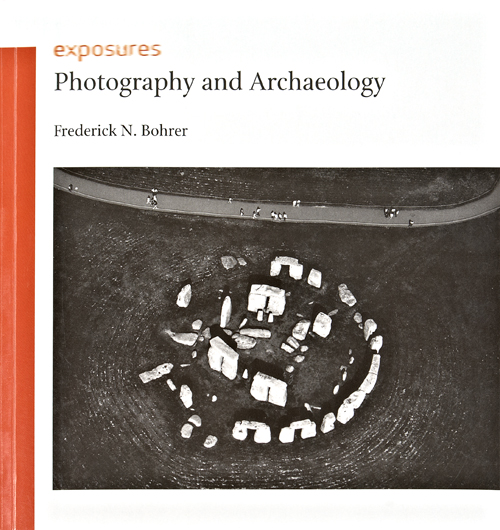| SIMON DENISON IMAGE & TEXT |
| PREVIOUS | NEXT |
PHOTOGRAPHY AND ARCHAEOLOGY Frederick N Bohrer Reaktion Books, 2011 ISBN 978-1-86189-870-8 Pb
Photography and archaeology were born and grew together. The term ‘archaeology’ was first used in its modern sense in 1837, two years before François Arago’s announcement of Daguerre’s photographic process to the French Chamber of Deputies. Arago himself drew attention in that speech to photography’s usefulness for archaeology, through its potentially speedy and accurate recording of hieroglyphics; and from the start, archaeology has indeed relied on photography as a principal means of generating evidence. Its dependency may even be growing, as first air archaeology, then satellite and geophysical imaging were developed to aid, and now often to replace, traditional excavation. Archaeology has always made use of ‘stunning’ photographs (the photograph to look at) in applications for funding or support, and in popularisation. But its primary desire has been for factual records, for accuracy and transparency (the photograph to look through), and in this it has regularly been disappointed. Photography’s unreliability may seem like a well-worn subject. Yet the long history of archaeology’s attempts to bend photography to its will allows this book – part of Reaktion’s excellently-produced Exposures series – to unearth numerous photographic curiosities and provide some fresh insights into an issue on which you might have thought there was little new to say. ‘The overwhelming difficulty of the archaeological photographer is to induce his camera to tell the truth,’ wrote British archaeologist Mortimer Wheeler in the 1950s. There were problems with artiness, with the limitations of technology or access, with the inherent distortions of the photographic eye. These problems archaeologists could see. Those they could not were the ways in which their intentions polluted the factual record they wished to create. In his influential 1904 manual, Methods and Aims in Archaeology, Flinders Petrie described how reliefs, tombs and trenches should be prepared for the camera by an elaborate cleaning and dressing process, producing images of sites and objects as they never appeared in any present or past reality (except in the photographic moment), in what is still standard practice. We find several examples here of archaeology co-opted to serve a cause, pulling photography along in its wake. The publication of German excavations at Olympia, starting in 1875, featured reconstructions of the site’s most spectacular find, a Nike (Victory) statue, in a visualisation highly reminiscent of the Victory Column erected in Berlin in 1873 to commemorate Prussia’s recent defeat of France. In the 1920s, excavations at Mohenjo-Daro in modern-day Pakistan revealed the existence of the great Indus Valley civilization, yet site director John Marshall sought to repress publication of these politically awkward findings within British India itself. In the 1900s, Sir Arthur Evans tampered with evidence at Minoan Knossos to construct photographs that supported his interpretation of the site. Archaeologists depict what they regard as important; and this extends to the site workers. Typically they, and all traces of their presence, are excluded in a quest for a kind of pure factuality. Site directors may merit a portrait, but diggers have typically been depicted only en masse, a faceless army. One especially telling image was made during French excavations at Delphi in 1894. For the dig to proceed a Greek village was relocated against the wishes of the villagers, who nonetheless served as site hands. In the image, a statue of Antinoüs holds centre stage, in sharp focus, with the villagers obediently ranged on either side, blurred, obscuring one another, in a structuring device that guides the eye to the statue, ‘posed,’ Bohrer writes, ‘… as if realizing the importance of the excavation and the unimportance of their own history’. British site photographer Dave Webb’s recent portraits of ordinary diggers, found in the online Diggers’ Alternative Archive, does a little to redress the balance. Photographs of archaeologists at work are also seen in the recent Greek-led Kalaureia Project, published in 2009. In a sophisticated but still untypical approach, this work moves away from the tradition of depicting site-as-fact, and takes account of our postmodern understanding of the subjective nature of knowledge. Archaeological truth is constructed initially in the minds of those doing the digging and is inflected by their experiences and values. We only see the past through the prism of the present. Archaeologists have long tried to minimise any nuancing of the evidence by creating a photographic archive. Archiving began early. In crude form it is found in some of the early daguerrotype expeditions. Now, it is not uncommon to have every site or trench photographed hundreds of times from every angle to reduce, as far as possible, any traces of authorship and intention. The archive functions to encourage reinterpretation. Yet even within the archive, photographs require captions, annotations, ordering. Mediation is unavoidable. In practice, archaeologists have often found photography compromised by its panoptic but surface vision, its inability to distinguish dross from gold or to show clearly what a trained eye in the field can see. Its fundamental inability to produce, on its own, an accurate and useful document has been shown above all by the Chicago Epigraphic Survey, founded in 1924 and based in Luxor. Its aim has been to do exactly what Arago claimed a single camera could quickly accomplish – the recording of the hieroglyphs – and yet, despite continuous progress, the project is still incomplete. Over time, the Survey has developed a laborious process to create records that are fit for purpose. A large-format photograph forms only the first step in the process which also involves draughtsmen, epigraphers and Egyptologists. At one point, the entire emulsion is bleached away to leave a line drawing which is later elaborated. So much for the supremacy of the photograph as a bearer of truth. |
 |
|---|---|